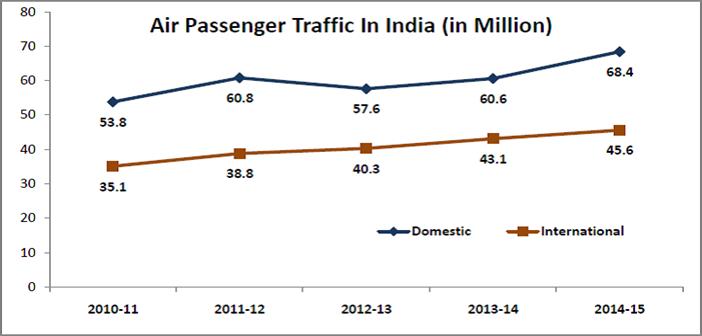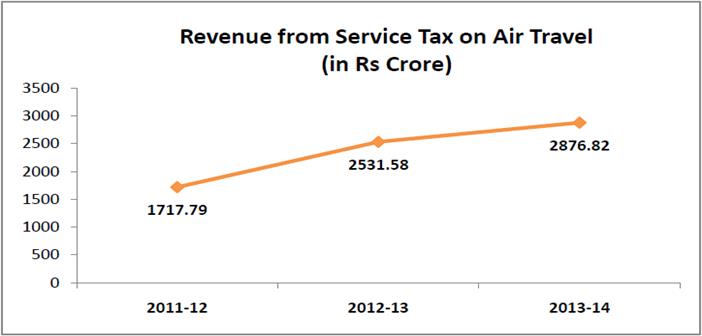[orc]The union cabinet has approved the new Civil Aviation Policy to be effective from the second quarter of this financial year. Among other things, the new policy talks about a Regional Connectivity Scheme to make use of the unused airstrips across the country and extend affordable air travel to the common man. To fund the scheme, the policy proposes to establish a Regional Connectivity Fund, to be financed by a levy on airfares.
The union cabinet has now approved the new ‘National Civil Aviation Policy’, 2016. The vision of this policy is to create an eco system, to enable 30 crore domestic tickets per year by 2022 which stands at around 7 crore in the year 2014-15. The policy in its mission statement mentions safe, secure, affordable and sustainable air travel with access to various parts of India and the world.
Air Passenger Traffic in India
The passenger traffic in the country has been steadily growing at an average rate of more than 8% in the last five years, except in 2012-13. In this period, India has registered the fourth fastest growth in passenger traffic after Japan, Brazil and China. As per data available with the Ministry of Civil Aviation, the domestic passenger traffic has grown from 53.8 million in 2010-11 to 68.4 million in 2014-15, a growth of more than 27%. Except for the dip in 2012-13, the domestic passenger traffic has continuously increased year after year. The international passenger, on the other hand has grown from 35.1 million in 2010-11 to 45.6 million in 2014-15, a growth of more than 42%.
Important parts of the Policy
The new policy covers the following major issues.
- Safety
- Regional connectivity
- 5/20 Rule
- Fiscal support
- Airports developed by State Government or Private sector or in PPP mode
- Airports Authority of India
- Aviation security, Immigration and Customs
- Ancillary Revenue
- Essential Services Maintenance Act, 1968
- Aviation education and skill development
Regional Connectivity
The policy proposes a Regional Connectivity Scheme (RCS) to be effective from the second quarter of 2016-17. The crux of the policy is to ensure that the all inclusive fare for a one hour flight on RCS routes shall not exceed Rs 2500 per passenger. This is in line with the vision of the policy to increase the domestic passenger traffic by fourfold in the next 7 years from about 7 crore to 30 crore.
The policy proposes a set of four different measures to be adopted for the implementation of RCS.
- Revival of un-served or under-served aerodromes and airstrips.
- Concessions by different stakeholders.
- Viability Gap Funding (VGF) for scheduled commuter airlines.
- Cost-effective security solutions by Bureau of Civil Aviation Security and State Governments.
The policy mentions that only 75 out of 450 airstrips/airports have scheduled operations as on date. The revival of these unused air strips as per demand is to be done by the Airports Authority of India (AAI) at a cost of 50 to 100 crore.
The policy also puts the onus on state governments to reduce VAT on Aviation Turbine Fuel (ATF) to 1% or less if the state governments wish to extend the RCS scheme to airstrips within their states.
The policy also proposes a set of subsidies by the Government of India for the scheduled commuter airlines (SCA) flying to RCS locations. The proposed subsidies include the following for a period of 10 years.
- No airport charges
- Service Tax will be levied only on 10% of the taxable value (abatement of 90%) of tickets for passengers embarking from or terminating in an RCS airport
- Provision of free police and fire services by State governments.
- Excise duty at a rate of 2% shall be levied on ATF drawn by SCA’s from the Regional Connectivity Scheme (RCS) airports
- Viability Gap Funding (VGF) indexed to ATF prices and inflation
VGF will be shared between Ministry of Civil Aviation and the State Government in the ratio of 80:20. For the North Eastern States, the ratio will be 90:10.The payment of the full amount of VGF will be made to the airline operator from the Regional Connectivity Fund (RCF) and the State Governments will be subsequently asked reimbursement.
How does the Government propose to fund this Scheme?
In the policy, the government has proposed a Regional Connectivity Fund (RCF). This RCF will be funded by a levy (cess) on all domestic routes other than Category II, RCS routes and small aircraft below 80 seats irrespective of the routes. The Aircraft Act of 1934 authorizes the government to levy such a cess. The policy also proposes easy entry and exit options for carriers into the RCS.
The revenue accrued to the government from service tax on Air Travel was about 2877 crore in 2013-14. Considering these numbers, a levy of 2% may not yield more than 3000 crore to the government.
Will these steps help improve the Air Passenger Traffic?
In terms of the domestic air passenger traffic, the scheme itself may not help more than 20000 to 30000 passengers a day, or about 1.2 crore passengers per year at best, based on the current data. To reach the target of 30 crore domestic ticketing by 2022, the passenger traffic has to grow upwards of 25% every year. At the current growth rate, these numbers look impossible. Whether such a growth will be fuelled by the RCS remains to be seen.
Other proposals in the Policy
The policy also proposes to encourage the use of civilian helicopters and charter operations to attract high end tourists. According to the new policy, India currently has less than 300 civilian helicopters, less than 25% of what Brazil has (over 1300). The policy also talks about skill development for the aviation sector and better security systems among other things.
Featured Image: By José Luis Celada Euba [CC BY-SA 2.0], via Wikimedia Commons





1 Comment
Pingback: What Does The Proposed National Aviation Policy Say | Swarajya